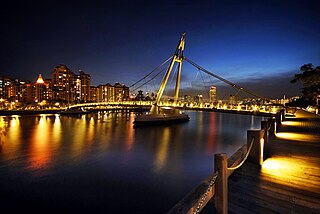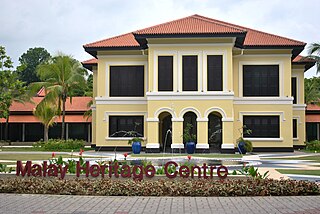The year 2004 in archaeology included many events, some of which are listed below.
Nanyang Sin-Chew Lianhe Zaobao, commonly abbreviated as Lianhe Zaobao, is the largest Singaporean Chinese-language newspaper with a daily circulation of about 136,900 as of 2021. Published by SPH Media, it was formed on 16 March 1983 as a result of a merger between Nanyang Siang Pau and Sin Chew Jit Poh, two of Singapore's oldest Chinese newspapers.

Kallang is a planning area and residential zone located in the Central Region of Singapore.
National monuments of Singapore are sites, buildings and structures in Singapore that have been designated by the National Heritage Board (NHB) as being of special historic, traditional, archaeological, architectural or artistic value. For historical significance, these buildings are not allowed to be demolished. The Preservation of Monuments Act gives the board authority to order the preservation of such sites and promote research and public interest in the monuments.

Fort Canning Hill, formerly Government Hill, Singapore Hill and Bukit Larangan, or simply known as Fort Canning, is a prominent hill, about 48 metres (157 ft) high, in the southeast portion of Singapore, within the Central Area that forms Singapore's central business district.

The Malay Heritage Centre is a cultural centre and museum located at Sultan Gate off Beach Road in Kampong Glam, Singapore. It showcases the culture, heritage and history of Malay Singaporeans.

Tanjong Rhu is a subzone within the planning area of Kallang, Singapore, as defined by the Urban Redevelopment Authority (URA). The perimeter of Tanjong Rhu is made up of Nicoll Highway in the north; Mountbatten Road and Fort Road in the east; East Coast Parkway (ECP) in the south; as well as Marina Channel and Kallang Basin in the west. Tanjong Rhu is the largest in terms of physical area among the nine subzones that make up Kallang.

Istana Kampong Glam, also Istana Kampong Gelam, is a former Malay palace in Singapore. It is located near Masjid Sultan in Kampong Glam. The palace and compounds were refurbished into the Malay Heritage Centre in 2004. The palace was gazetted as a national monument on the eve of Singapore's Golden Jubilee, on 6 August 2015.

Gedung Kuning is a Malay historical residence in Singapore. Located at 73 Sultan Gate, Gedung Kuning stands just outside the Malay Heritage Centre, near Masjid Sultan in the historic district of Kampong Glam in Singapore. However, from 1919 to 1925, the Gedung Kuning's address was 33 Sultan Gate. Once forming an annexe to the adjacent palace of Singapore's Malay rulers, Istana Kampong Glam, it became the private residence of Haji Yusoff, a prominent Malayo-Javanese merchant and four generations of his family. Together with the Istana, the compound was refurbished as part of the development of the Malay Heritage Centre in 2004.

Jamestown Rediscovery is an archaeological project of Preservation Virginia investigating the remains of the original English settlement at Jamestown established in the Virginia Colony in North America beginning on May 14, 1607.

Fort Tanjong Katong, which stood from 1879 to 1901, was one of the oldest military forts built by the former British colonial government of Singapore. The fort gave its name to today's Fort Road, and it used to stand on the grounds of the present Katong Park. Fort Tanjong Katong, the only one of its kind on the eastern side of the island, was part of a series of defensive batteries and fortifications along the southern coast of Singapore, that defended the eastern approaches to the Singapore Harbour and Singapore Town against seaborne attacks. Due to its poor structural design and remoteness, the fort was subsequently abandoned and buried until its rediscovery in 2001. Found with traces of a moat and near intact perimeter wall, the fort was considered by local archaeological experts as one of Singapore's most important archaeological finds of a "true 19-century fort" to date. As a result, an archaeology group has been lobbying for the site to be gazetted as a National Monument. As of May 2010, the National Heritage Board has stated that it has no plans to gazette the fort for the time being.

Beifudi is an archaeological site and Neolithic village in Yi County, Hebei, China. The site, an area of 3 ha on the northern bank of the Yishui River, contains artifacts of a culture contemporaneous with the Cishan and Xinglongwa cultures of about 8000–7000 BP, two known Neolithic cultures east of the Taihang Mountains, and thus fills an archaeological gap between the two Northern Chinese cultures. The total excavated area is more than 1,200 square meters and the collection of neolithic findings at the site has been conducted in two phases.
The names of Singapore include the various historical appellations as well as contemporary names and nicknames in different languages used to describe the island, city or country of Singapore. A number of different names have been given to the settlement or the island of Singapore all through history, the earliest record may have been from the 2nd century AD. Possible mentions of Pulau Ujong, the name for the island of Singapore, may be found in Chinese works, and it was also referred to as Temasek in Malay and Javanese literature. Sometime in the 14th century the name was changed to Singapura, which is now rendered as Singapore in English. Singapura means "Lion City" in Sanskrit, and Sang Nila Utama is usually credited with naming the city, although its actual origin is uncertain.

Tutuala is a village and suco in the subdistrict of Tutuala. It is situated at the extreme eastern end of Timor. Its population at the 2004 census was 3,707. The subdistrict of Tutuala comprises two sucos, including Mehara and Tutuala with the subdistrict administrator residing in Tutuala. The suco of Tutuala comprised four hamlets (aldeia): Ioro, Pitileti, Tchailoro, and Vero. The main Fataluku language areas of the country are in Tutuala, as well as Lautem and Fuiloro.
Samrong Sen on the east bank of the Stueng Chinit River is a prehistoric archaeological site in the Kampong Chhnang Province, Cambodia. Consisting of a very large fluviatile shell midden, it flourished in particular from 1500 BC to 500 BC.

Katong Park MRT station is a future underground Mass Rapid Transit station on the Thomson–East Coast line situated at the boundary of the planning areas of Kallang and Marine Parade, Singapore. The station is located underneath the junction of Fort Road, Tanjong Rhu Road and Meyer Road and will serve the Katong Park.

Ban Zu or Banzu was a port settlement believed to have thrived in Singapore during the 14th century. It is thought to be located on Fort Canning Hill and the area on the north bank of the Singapore River basin between the hill and the sea. It was mentioned by the Chinese traveller Wang Dayuan in his work Daoyi Zhilüe together with Long Ya Men as the two settlements that made up Temasek. It may have been abandoned before 1400 after an attack by either the Siamese or the Majapahit.

Katong Park is neighborhood park located in Katong, Singapore at the junction of Meyer Road and Fort Road. Built in the 1930s above the buried remains of Fort Tanjong Katong, it was one of Singapore’s oldest parks with the first public bathing pagar and was highly popular with families during the weekends. After the coastal reclamation works in the 1970s, the park lost its sea frontage and declined greatly in popularity. It now remains as a small community park serving nearby residents.
John Norman Miksic is an American-born archaeologist.













